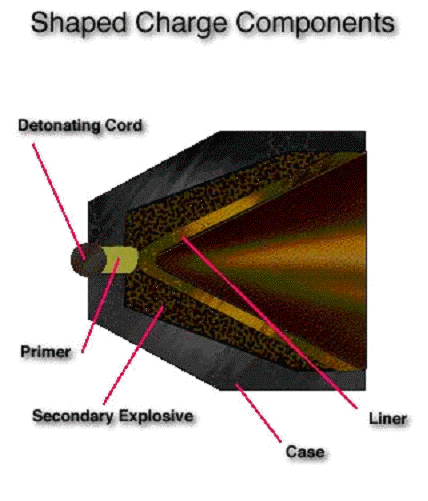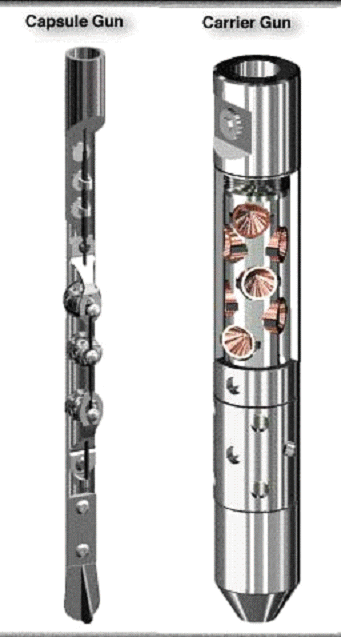
This section will discuss the perforating process. This domain introduction is provided so that the reader will be familiarized with the basic concepts of a perforation job in order to understand and use the Perforation section of the data model. This is not an exhaustive introduction. References to more complete domain information will be provided.
Perforation is the act by which communication tunnels are created from the casing or liner into the reservoir formation through which oil or gas can be produced. The most common method uses jet-perforating guns equipped with shaped explosive charges.

A shaped charge is used to create the communication channel between the casing or liner and the production reservoir. Detonating a shaped charge creates a jet of gas, which in turn creates an opening in the casing and travels into the reservoir.
There are two main types of perforating guns currently being used in the field. These are Capsule guns and Carrier guns.
� Capsule guns are perforating guns in which the shaped charge is individually packaged in an exposed, but pressure-tight case.
� Carrier guns contain a group of shaped charges enclosed in a steel carrier.

There are three main methods of deploying perforating guns:
� Wireline Conveyed Perforation: Where the gun is lowered into the hole by wireline and when the guns are positioned across the zone of interest, they are fired by sending a high direct current (DC) voltage down the wireline cable.
� Tubing (or Drill Pipe) Conveyed Penetration: Tubing Conveyed Penetrating (TCP) guns are used in situations where either under balanced perforating is desired over a long interval or when the deviation is so high that wireline conveyed guns cannot be used. TCP is an efficient way of perforating long intervals because it minimizes the number of trips in the hole. After being fired, TCP guns can be dropped from the work string provided there is sufficient rathole into which they can fall. Depth Control in TCP Operations is a critical issue in ensuring that the guns are on-depth when fired.
� Coiled Tubing: Coiled tubing conveyed perforating systems, similar in concept to TCP, are especially useful in horizontal wells. In addition, coiled tubing can be used in virtually any TCP or wireline conveyed perforating application. Coiled tubing perforating can be performed with or without wireline. When wireline is used, it must be run inside the coiled tubing. This is done by pumping the wireline through the entire length of coiled tubing on the reel to be used. The guns are then connected to, and actuated by, the wireline. Without wireline, the guns are connected to the coiled tubing and actuated by pumping a ball through the coiled tubing. The ball can then be pumped, or possibly allowed to drop (after passing the goose-neck), to the top of the perforating guns. This enables a specially designed firing head to be actuated and fires the guns. When the guns are pushed into a horizontal section of the well, their length is often a consideration. If the guns are too long, the mechanical strength of the coil tubing can be exceeded. This will buckle the coiled tubing, causing it to bunch-up and get stuck.